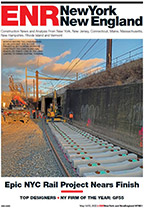News Wrap: New FEMA Flood Maps; Rapid Repairs Update; Tristate M&A Flat; NYC Gets New MWBE Law
New York

At-Risk Homes Now Face FEMA's New Flood Maps
With the senate's recent passage of a $50.5-billion Superstorm Sandy aid bill, some hard-hit homeowners in New York and New Jersey now face a new issue as the Federal Emergency Management Agency recently released new flood elevation map data for the city that details how rebuilding should occur. The new maps double the number of NYC properties lying in flood zones, and FEMA advises homeowners to build higher.
At press time, however, New York Mayor Mike Bloomberg signed an emergency order to suspend height and other restrictions so that buildings can meet the new flood elevation standards. The city also adopted a new rule to increase the required minimum flood proofing elevation so that substantially damaged buildings and other new construction are built to withstand greater flood risk.
The move should help New Yorkers limit the cost of future federal flood insurance premiums by better protecting properties in flood-prone areas from risk and damage, the mayor says.
"We are beginning the process of updating our building code and zoning regulations so that new construction meets standards that reflect the best available data about flood and climate risks," Bloomberg said in a Jan. 31 statement announcing the new measures.
"Homeowners need to be able to rebuild to sound flood protection standards without facing conflicts with current zoning regulations," Amanda M. Burden, city planning commissioner, said in the same statement.
The city says that it will work with the federal government and others to create programs that may assist property owners with compliance with the new recommended elevations.
New York
NYC's Rapid Repairs Program Makes Strides
New York City Rapid Repairs Program completed work on more than 10,000 residences as of Jan. 17 in areas hit hard by Superstorm Sandy, according to a Jan. 20 announcement from New York Mayor Michael Bloomberg.
Under the program so far, the city says it has completed 6,072 buildings and 10,492 residential units. It says work has begun in 7,878 buildings, with 4,303 buildings remaining.
The free city program, in partnership with FEMA, is aimed at helping residents quickly make emergency repairs.
Under the initiative, the city sends teams of contractors to homes to permanently or temporarily restore heat, power and hot water and make other "limited" repairs to protect a home against further significant damage, the city says.
New York
U.S. Deal Growth Climbs, But N.Y. Market Flattens
Industry merger and acquisition activity grew 14% to about 200 deals nationwide last year but was relatively flat in the tristate region, says Mick Morrissey, managing principal at A/E/C management consulting firm Morrissey Goodale, Newton, Mass. Even so, many buyers continued to view the tristate region as a good place to spend their M&A dollars.
"New York tends to be a harder place [for an outside firm] to get into. That said, it tends to be one of the most popular states" for deals, Morrissey says. "That's because it is a significant economy—a world unto itself that's a very attractive place to be because it has so much work" compared with many other regions, he says. Given the state's stringent licensing and practice laws, it is also easier and quicker for an outsider to enter the market via acquisition, he adds. New Jersey is another favorite market, largely because of its proximity to New York.
"Nobody does a lot of deals in Duluth, Minnesota, so you don't want to spend your acquisition dollars there," Morrissey says. "Nobody buys firms in Mississippi, but the state beside it, Louisiana, is one of the hottest states—firms outside of the state are buying into Louisiana because they want to get into the oil action."
Last year, some 26 firms—primarily in the architecture and engineering sector as well as the environmental consulting, land surveying and landscape architecture practices—changed hands in New York, compared with 25 in 2011 and 18 in 2010, according to Morrissey Goodale. In 2012, there were 11 deals done in New Jersey and three in Connecticut.
M&A activity in the region last year included Woburn, Mass.-based GEI Consultants's purchase of Garden City, N.Y.-based EEA, a 14-person environmental and ecological consultancy; Lansing, Mich.-based Capital Consultants Architecture and Engineering's merger with Canton, N.Y.-based Burley-Guminiak & Associates; San Diego-based Kleinfelder's acquisition of Princeton, N.J.-based Omni Environmental; and Chicago-based Alfred Benesch & Co.'s merger with Glastonbury, Conn.-based Purcell Associates.
Those types of deals, in which a buyer in one state scoops up market share in another, tended to be the growth strategy of industry firms prior to the recession. However, "since the recession and even more so in 2011 and 2012, closer to half the deals done in our industry have been within states," he says.
Intrastate deals in the region last year included North Stonington, Conn.-based A/Z Corp.'s merger with Hartford-based PMKArchitecture+Interiors; Sparta, N.J.-based CP Engineers's asset purchase of Sparta-based engineering firm Cerenzio & Panaro; and Patchogue, N.Y.-based BBS Architects & Engineers' acquisition of Bohemia, N.Y.-based Ward Associates.
Blame the beating that balance sheets took during the recession when clients either did not pay in a timely manner or, worse yet, not at all, Morrissey says. "What we saw in 2011 and 2012 were firms [hit hard by the economy] that started talking with firms they knew who were in the same boat," and so the two combined forces, he says.
One trend prior to 2011 was that large, publicly traded firms initiated about one-third of the U.S. deals, Morrissey says. But in 2011 and 2012 only about one-fifth of such firms did so "because a lot of them turned their sights on overseas markets where they saw relatively greater opportunities."


